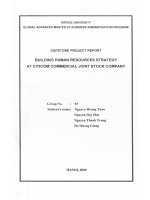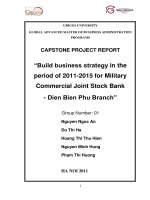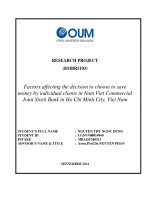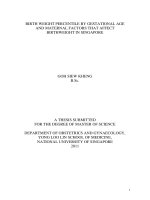The factors that affect organizational citizenship behaviors at the viet nam international commercial joint stock bank
Bạn đang xem bản rút gọn của tài liệu. Xem và tải ngay bản đầy đủ của tài liệu tại đây (1.18 MB, 74 trang )
RESEARCH PROJECT
(BMBR5103)
THE FACTORS THAT AFFECT ORGANIZATIONAL
CITIZENSHIP BEHAVIORS AT THE VIETNAM
INTERNATIONAL COMMERCIAL JOINT STOCK BANK
STUDENT’S FULL NAME
:
VU DUC THINH
STUDENT ID
:
CGS00018262
INTAKE
:
MAY 2014
ADVISOR’S NAME & TITLE
:
DR. NGUYEN THE KHAI (DBA)
AUGUST, 2015
Business Research Methods
DR. NGUYEN THE KHAI
ADVISOR’S ASSESSMENT
------------------------------------------------------------------------------------------------------------------------------------------------------------------------------------------------------------------------------------------------------------------------------------------------------------------------------------------------------------------------------------------------------------------------------------------------------------------------------------------------------------------------------------------------------------------------------------------------------------------------------------------------------------------------------------------------------------------- ------------------------------------------------------------------------------------------------------------------------------------------------------------------------------------------------------------------------------------------------------------------------------------------------------------------------------------------------------------------------------------------------------------------------------------------------------------------------------------------------------------------------------------------------------------------------------------------------------------------------------------------------------------------------------------------------------------------------------------------------------------------------------------------------------------------------------------------------------------------------------------------------------------------------------------------------------------------------------------------------------------------------------
VU DUC THINH – MBAOUM K14C
Business Research Methods
DR. NGUYEN THE KHAI
TABLE OF CONTENTS
ABSTRACT .................................................................................................................... 1
ACKNOWLEDGEMENT ............................................................................................. 2
LIST OF TABLES ......................................................................................................... 3
LIST OF CONFIGURES .............................................................................................. 4
ABBREVIATION .......................................................................................................... 4
CHAPTER I: INTRODUCTION ................................................................................. 5
PART A – RESEARCH INTRODUCTION ................................................................ 5
1.1
Research Problem Statement: ................................................................................ 5
1.2
Significance of Research........................................................................................ 6
1.3
Scope of the Research ............................................................................................ 7
1.4
Purpose of the Research ......................................................................................... 7
1.5
Research Methodology .......................................................................................... 7
1.5.1. Primary data ........................................................................................................... 7
1.5.2 Secondary data ........................................................................................................ 8
1.6
The Structure of the Research ................................................................................ 8
PART B – OVER VIEW OF THE VIB ........................................................................... 9
Product and Brand Name ............................................................................................... 10
Business Objective ......................................................................................................... 12
Human Resources Management ..................................................................................... 14
VU DUC THINH – MBAOUM K14C
Business Research Methods
DR. NGUYEN THE KHAI
CHAPTER II: LITERATURE REVIEW AND HYPOTHESES ............................ 17
2.1
Organizational Citizenship Behaviors (OCB) ..................................................... 17
2.2 Organizational commitment (OC) ........................................................................... 22
2.3 Job demands and Decision latitude (JD) .................................................................. 24
2.4 Person-Organization Fit (POF) ................................................................................ 26
2.5 Job Satisfaction relative to expectations (JS) ........................................................... 27
2.6 The relationship between OC and OCB ................................................................... 28
2.7 The relationship of JD and OCB .............................................................................. 29
2.8 The relationship POF and OCB ............................................................................... 30
2.9 The Relationship of JS and OCB ............................................................................. 32
CHAPTER III: RESEARCH METHODOLOGY .................................................... 34
3.1 Research Model:....................................................................................................... 34
3.2 Survey Process ......................................................................................................... 35
3.2.1
Primary data ...................................................................................................... 35
3.2.2
Secondary data .................................................................................................. 36
3.2.3 Survey process ...................................................................................................... 36
3.3 Measure of each Construct ....................................................................................... 38
3.3.1 Organizational Citizenship Behaviors .................................................................. 38
3.3.2 Person-Organization Fit ........................................................................................ 39
3.3.3 Job demands and Decision latitude ....................................................................... 40
3.3.4 Organizational Commitment ................................................................................. 41
VU DUC THINH – MBAOUM K14C
Business Research Methods
DR. NGUYEN THE KHAI
3.3.5 Job satisfaction relative to expectations ................................................................ 42
CHAPTER IV: ANALYSIS AND RESULTS ........................................................... 43
4.1 Overview of respondents’ information .................................................................... 43
4.2 Reliability Statistics ................................................................................................. 46
4.3 Descriptive Statistics ................................................................................................ 48
4.4
Hypotheses Testing Results: ................................................................................ 49
4.4.1 Hypothesis proposed (H1)..................................................................................... 50
4.4.2 Hypothesis proposed (H2)..................................................................................... 51
4.4.3 Hypothesis proposed (H3)..................................................................................... 51
4.4.4
Hypothesis proposed (H4) ................................................................................ 51
5.1 Summary of the Results: .......................................................................................... 53
5.2 Discussion and Recommendation. ........................................................................... 54
5.3 Limitation and Future Research ............................................................................... 55
REFERENCES ............................................................................................................. 56
APPENDIX 1 - QUESTIONNAIRES ........................................................................ 61
APPENDIX II - PRESENTATION SLIDES ............................................................. 67
VU DUC THINH – MBAOUM K14C
Business Research Methods
DR. NGUYEN THE KHAI
ABSTRACT
Organization citizenship behaviors (OCB) are individual and voluntary behaviors
that are not stated directly by formal system. They make increase in effectiveness
and efficiency of organizational performance.
The quality of human resource, one of the basic and important elements, is
indispensable for every business in general and banks in particular during the
existence and development. After stage spike when the number of banks in Vietnam
was established new and expanded operations phase from 2000 to 2012, due to the
impact of the financial crisis and restructuring, system banks have tended to
transform descending towards decreasing the quantity and increasing the quality.
But besides the formed standards for the employees, the other factors that is not
stated that affecting this, it is called the Organization citizenship behaviors.
This study examines the structure of OCB and its relation to Organizational
commitment (OC), Job satisfaction relative to expectations (JS), Job demands and
Decision latitude (JD), Person-Organization Fit (POF) at VIB. Data was collected
through the use of standardized questionnaires. Two-hundred and ninety seven
employees of VIB filled out standardized questionnaires. The collected data were
computed and analyzed through factor analysis, Cronbach’s alpha, descriptive
statistics, multiple regression analysis. Based on results analysis, researcher makes
some suggestions to the managers of VIB to improve VIB’s performance.
Key words: Organizational citizenship behaviors, Organizational commitment, Job
satisfaction relative to expectations, Job demands and decision latitude, PersonOrganization Fit.
VU DUC THINH – MBAOUM K14C
1
Business Research Methods
DR. NGUYEN THE KHAI
ACKNOWLEDGEMENT
I would like to express my deepest gratitude to my research Instructor, Professor
Khai Nguyen The for his intensive support, valuable suggestions, guidance and
encouragement during the course of my study.
I would like to express my sincere gratitude to all great lecturers at the MBA
program for an enjoyable learning experience that has increased my knowledge.
I would like to specially express my thanks to all of my classmates, my friends for
their support and encouragement.
I would like to express my thanks to all my colleagues at VIB who are willing to
join and complete my survey in this work in valuable way or another..
Finally, I heartily dedicate this study to my beloved parents and my wife, who have
always sacrificed to encourage and support me during my study.
August, 2015
VU DUC THINH
VU DUC THINH – MBAOUM K14C
2
Business Research Methods
DR. NGUYEN THE KHAI
LIST OF TABLES
Table 4.1: Result of Survey.......................................................................................43
Table 4.2: Sample Description ..................................................................................45
Table 4.3: Reliability Test for employees of VIB - OC ............................................46
Table 4.4: Reliability Test for employees of VIB - JD .............................................47
Table 4.5: Reliability Test for employees of VIB - POF ..........................................47
Table 4.6: Reliability Test for employees of VIB - JS..............................................47
Table 4.7: Reliability Test for employees of VIB - OCB .........................................47
Table 4.8: Descriptive Statistics ................................................................................48
Table 4.9: Variables Entered/Removeda ...................................................................49
Table 4.10: Model Summary.....................................................................................50
Table 4.11: Coefficientsa ...........................................................................................50
Table 4.12: hypothesis result.....................................................................................52
VU DUC THINH – MBAOUM K14C
3
Business Research Methods
DR. NGUYEN THE KHAI
LIST OF CONFIGURES
Figure 1.1 : Human resource manager system of VIB ..............................................13
Figure 1.2 : Personel Structure (Source : VIB – Annual Report 2014) ...................16
Figure 3.1 : the proposed research model of the factors affect the Organizational
Citizenship Behaviors of the employees at VIB. ......................................................34
ABBREVIATION
OCB
Organizational Citizenship Behavior
OC
Organizational commitment
JS
Job satisfaction relative to expectations
JD
Job demands and Decision latitude
POF
Person-Organization Fit
VIB
The Vietnam International Commercial Joint Stock Bank
SPSS
Statistical Package for Social Science
VU DUC THINH – MBAOUM K14C
4
Business Research Methods
DR. NGUYEN THE KHAI
CHAPTER I: INTRODUCTION
The first chapter will introduce basic of the research : Research Problem Statement,
Purpose of the Research, Scope of the Research, Significance of the Research,
Research Methodology, and Structure of this Research. The final of the chapter will
supply briefly information of Vietnam International Commercial Joint Stock Bank
(VIB).
PART A – RESEARCH INTRODUCTION
1.1 Research Problem Statement:
A bank is a financial institution offering deposits subject to withdrawal on demand
and providing loans to the retails or corporate sector. The role of bank is more and
more important in the world as well as Vietnam nowadays and there are a lot of
students want to develop his knowledge in banking services, including the
Organizational Citizenship Behavior in banking.
Organization citizenship behaviors (OCB) are individual and voluntary behaviors
that are not stated directly by formal system. The reason of researching OCB is that
every organization, in order to sustain competition and long-term profitability,
businesses, devotes themselves not only to attracting new customers but also to
retaining existing customers (Yang, 2005). Several studies have demonstrated that
OCB makes increase in effectiveness and efficiency of organizational performance.
Therefore, improving the employees’ OCB is a critical issue for business managers
in today’s competitive global marketplace). Ensuring excellent service quality and
high customer satisfaction is an important issue and a challenge for the service
industry (Hung et al., 2003).
VU DUC THINH – MBAOUM K14C
5
Business Research Methods
DR. NGUYEN THE KHAI
However, until now most of local commercial banks in Vietnam do not take into
account the importance of OCB. The evidences are that there are very rare of
researches and journals about the relationship between OCB and customer
satisfaction and long term development of the company especially of the bank.
Furthermore, with the increasing shortage of talented workers, labor turnover in
Vietnamese banking services has now become a major issue. According to Dutta et
al (2007), the turnover rate in banking service is significantly high, 20%-30%
professionals. Therefore, the research lays its focus on the topic “The factors
affecting the Organizational Citizenship Behavior in Vietnam International
Commercial Joint Stock Bank”.
There is a tendency of human resource in banking at the present is moving on the
bank stability and tend to thrive in the future. And The Vietnam International
Commercial Joint Stock Bank (VIB) is one of them with staff increasing from the
other banks and even from former employees have left the VIB also returned.
With the strategy of sustained growth and enhanced safety, VIB is also the only
bank to be held credit ratings international Moody's upgrades, becoming 1 of 2 bank
index financial strength highest of 9 major banks in Vietnam is Moody's assessment
of the past year. This is also one of the first 10 bank was chosen by The State Bank
of Vietnam to pilot Basel II standards in bank management. The researcher make a
question: ―What make the bank is better?‖ and in the answer of the researcher, one
of the factors is the increasing of employees’ Organizational Citizenship Behavior.
1.2 Significance of Research
This research is conducted with the aim to have an understanding of the factors
influencing Organizational Citizenship Behaviors at VIB. The result of the Research
will give the data for the Board of Director and Human Resources Department make
decision to let VIB employees more effective.
VU DUC THINH – MBAOUM K14C
6
Business Research Methods
DR. NGUYEN THE KHAI
1.3 Scope of the Research
Due to knowledge and time limitations this dissertation can only focus on the
employees’ Organizational Citizenship Behaviors in VIB.
1.4 Purpose of the Research
The purpose of this Research is to examine the relationships between
Organizational Citizenship Behaviors with Job satisfaction relative to expectations,
Organizational commitment, Job demands and Decision latitude and Person Organization fit of employees of VIB.
The research will answer these questions:
1. What are the relevant theories of Organizational Citizenship Behaviors in
working environment?
2. What is the current status of employees’ satisfaction in VIB?
3. What are the recommendations to improve the employees’ Organizational
Citizenship Behaviors in VIB?
1.5 Research Methodology
The research has conducted qualitative and quantitative approaches on both of
primary and secondary data.
1.5.1. Primary data
The primary data used in the research is a questionnaires survey. The questionnaires
is provided to the author’s colleagues who currently work at VIB. The author
believed the reliable of answer is sufficient due to the following reasons:
Each question was designed to focus on single issues. The question format is
clear and simple;
VU DUC THINH – MBAOUM K14C
7
Business Research Methods
DR. NGUYEN THE KHAI
The sample size is 380 employees in different departments in VIB to make
sure the answer of each candidate are not affected by others.
Before performing the survey, the author designed cross-check questions
with a group of voluntary people to make sure the questionnaires are very
clear to understand.
Once the data is collected, there are several techniques can be applied to analyze the
data. The most common technique is descriptive data analysis such as charts, tables
and mean value. The author also applies the inferential data analysis that uses
information obtained from a small group to make judgment about larger group. In
the research, the sample interview may not reflect the sense of VIB bank system. By
conducting judgment-based approach such as the real situation of human resource
management, the author can assess the relationship between the sample answer and
the whole system.
1.5.2 Secondary data
The secondary data is documents related to Organizational Citizenship Behaviors in
banking industry and other published materials that are taken from Internet such as
websites, e-books and other in libraries or newspapers. All these sources are
authentic and will be listed out in the reference section.
1.6 The Structure of the Research
The research contains five chapters as described below:
Chapter I - Introduction
This chapter explains the reason of choosing the title, and briefly explains the
problem and objectives of the research. The scope and data collection methods of
the research are also presented in this part.
VU DUC THINH – MBAOUM K14C
8
Business Research Methods
DR. NGUYEN THE KHAI
Chapter II - Literature reviews and Hypothesis
This chapter presents the relevant concepts used as foundation for analysis,
suggestions and solutions in this research. It includes the relationship of
Organizational Citizenship Behaviors and Job satisfaction relative to expectations,
Organizational commitment, Job demands and Decision latitude and Person Organization fit. From that, the author give the hypothesis.
Chapter III - Research methodology
This chapter is set to provide the research model, the methodology used and how
the author processes the data received from survey.
Chapter IV - Research analysis and results
This part defines and analyzes the table of questionnaires achieved from survey
with employees at VIB.
Chapter V: Discussion and conclusions
This part recommends the most suitable solutions and conclusion conducted from
analyses from previous chapters.
PART B – OVER VIEW OF THE VIB
Vietnam International Commercial Joint Stock Bank, abbreviated Vietnam
International Bank (VIB), was founded on 18th September 1996. After 19 years of
operation, VIB has become one of the leading commercial joint stock banks in
Vietnam, with total assets of nearly VND 80,000 billion. The bank’s charter capital
is now VND 4,250 billion while its shareholders’ equity is nearly VND 8,200
billion. Currently, VIB has approximate 4,000 people working at nearly 160
branches and transaction offices in 27 key provinces/ cities across the country.
VU DUC THINH – MBAOUM K14C
9
Business Research Methods
DR. NGUYEN THE KHAI
2010 marked a significant development milestone of VIB by a strategic partnership
with the Commonwealth Bank of Australia (CBA) – the Number One retail bank in
Australia and the world’s leading bank with over 100 years of experience. This
strategic partnership facilitates VIB’s improvement in capital, technology, and risk
management… in order to successfully implement the long-term plans in the bank’s
business strategy and especially to improve the customer service quality in line with
international standards.
Being one of the pioneers in reforming business activities, VIB always takes its
customers as the focus and its service quality and innovative solutions as the
business motto, with the determination ―to be the most innovative and customercentric bank of Vietnam‖. Since its foundation, one of the missions defined by the
bank’s leaders is to be ―excellent in providing innovative solutions to satisfy
customers’ maximum needs‖. Therefore, VIB has been enhancing its efficiency in
the use of capital and management capacity and continuing to focus on the
development of retail banking networks and new products through diversifying
distribution channels in order to provide financial solution packages to focused
customer groups, and simultaneously improving the service quality to increasingly
better serve customers.
Product and Brand Name
Product:
The principal activities of the Bank are to mobilise and receive short, medium and
long-term deposit funds from organizations and individuals; to lend on a short,
medium and long-term basis up to the nature and ability of the Bank’s capital
resources; to conduct settlement and cash services and other banking services as
approved by the SBV; to conduct investments in associates, joint-ventures and other
companies; investments in bonds and deal in foreign exchange in accordance with
applicable regulations.
VU DUC THINH – MBAOUM K14C
10
Business Research Methods
DR. NGUYEN THE KHAI
Brand name:
Brand positioning statement
VIB is one of Vietnam’s top joint stock commercial banks that always put its
customers’ needs first. Professional staff build lasting relationships by listening to
customers and working with them in a thoughtful, open and collaborative manner.
Our deep understanding of local, needs, global perspective and commitment to
simplifying the banking experience enable us to help our customers plan their
future, achieve their dreams and focus on the more important things in life.
VIB’s logo
Our logo is formed by 3 letter V’s representing the connections, resources and
relationships we offer our customers and partners. In the center of the three V’s,
there is a heart image indicating that customers are always in the heart of VIB.
Emotionally, the three V’s forms a human shape with welcoming arms, symbolizing
the human spirit, and expressing the concept "Human Connection" in VIB’s brand.
The word ―VIB‖ is designed with a curved, slender shape, and the stylized ―V
represents a smile to welcome our customers. The blue and three shades of warm,
energetic orange colour creates an open space, bringing the sense of an open, easily
accessible, friendly and cooperative environment.
Brand personality attributes:
Genuine: We earn our customers' respect by acting with integrity,
professionalism and sincerity.
Nurturing: We take a long term view and help our customers grow and
succeed.
VU DUC THINH – MBAOUM K14C
11
Business Research Methods
DR. NGUYEN THE KHAI
Modern: We seek and leverage on the best banking practices and advanced
technologies.
Performance oriented: We are committed to going the extra mile and
delivering results.
Intuitive: We stay in tune with the changing needs of our customers and
adapt accordingly with new products and services.
Business Objective
Vision:
To be the most innovative and customer-centric bank of Vietnam.
Mission:
For customers: To excel in providing innovative, customer-centric solutions
to satisfy the needs of our customers.
For employees: To cultivate a high performance culture, entrepreneurship
and openness in our work environment.
For shareholders: To provide sustainable and attractive returns to our
shareholders.
For the community: To support community development
Core values:
Customers focus
Excellence
Honestly
Teamwork
Disciplined
VU DUC THINH – MBAOUM K14C
12
Business Research Methods
DR. NGUYEN THE KHAI
Rewards
Fastest growing Retail Bank Vietnam 2015 and Best Banking Deal Vietnam
2015 – Global Banking and Finance Review
Leading SME Trade Bank – Asian Development bank (ADB)
Excellent Brand of Vietnam 2014 – Vietnam Economic Times and Trade
Promotion Agency (Ministry of Industry and Trade)
Organization Structure
Figure 1.1 : Human resource manager system of VIB
VU DUC THINH – MBAOUM K14C
13
Business Research Methods
DR. NGUYEN THE KHAI
Human Resources Management
At the end of 2012, VIB initiated the transition from a HRM model by geographic
area to a centralized system headquartered at Head office, in which all HR function
are managed by Head office HR staff. A HR partnership model for business units
was also introduced.
After two years of implementation, the productivity of HR employees have been
markedly improved: total HR staff was gradually trimmed down from 93 (2012) to
65 2013) and 40 (2014), increasing the average number of staff portfolio managed
by on HR staff by 31% (from 65 in 2012 and 85 in 2014). HR staff receive frequent
training, and are provided ample opportunities for occupational development
through various HRM tasks. The quality of services provided to in-house clients
have therefore continually improved: faster, more consistent, and suited to the
realities of each Divisions.
VIB has identified staff fraud and corruption as a serious operational risk. In
addition to financial losses, staff fraud is almost certainly creating significant brand
and reputation damage for VIB.
This situation calls for a comprehensive and BOD-sponsored anti-fraud and
corruption program. Therefore, the motivation of this project is to set up the
foundation to fight fraud and corruption within VIB, reducing our losses to fraud
and corruption, improving the working culture of VIB, and developing our brand on
honesty and integrity.
VIB develops the foundation for preventing, detecting, investigating and
disciplining cases of Fraud and Corruption, including:
-
Anti-Fraud and Corruption Policy
-
Internal Fraud and Group Investigation Unit
-
Gifts and Entertainment Policy
-
Whistleblower Policy and Process
VU DUC THINH – MBAOUM K14C
14
Business Research Methods
DR. NGUYEN THE KHAI
-
Internal Investigation Process
-
Discipline Policy and Process
-
Training and Communications
-
Fraud Risk Assessments of all business areas
Personnel structure
At the end of 2014, VIB has 3,436 employees (As Annual Report 2014)
VU DUC THINH – MBAOUM K14C
15
Business Research Methods
DR. NGUYEN THE KHAI
Figure 1.2 : Personnel Structure (Source : VIB – Annual Report 2014)
VU DUC THINH – MBAOUM K14C
16
Business Research Methods
DR. NGUYEN THE KHAI
CHAPTER II: LITERATURE REVIEW AND HYPOTHESES
Chapter two presents the definition of OCB of employee and overview of the
theoretical basis related to the research problem. Researchers selected the following
variables : Job satisfaction related to expectations, Organizational commitment, Job
demands and decision latitude, and Person-Organization Fit affect OCB. The basis
of these Theories proposed the relationship and hypotheses for research.
2.1 Organizational Citizenship Behaviors (OCB)
During the stay of an employee in the organization, there are certain behaviors
which are expected from him and are abiding on him by the rules and regulations of
the organization. However employees at times exhibit certain behaviors that go
beyond the call of the duty. Such behavior is called Organizational Citizenship
Behavior (OCB). OCB is also known as extra role behavior. It is the behavior over
and above the normal course of duty and beyond the arena of legislations/ rules/
regulations. OCB refers to behavior that is not formally requested or directly
rewarded but can be functional to the operations of an organization (Smith, Organ,
& Near, 1983). Organizations cannot survive or prosper without their members
behaving as good citizens by engaging in all sorts of positive behaviors.
Researchers (see Bateman & Organ, 1983; Organ, 1983; 1990; 1997; Organ &
Lingl, 1995; Organ & Moorman, 1993; Penner, Midili, & Kegelmeyer, 1997; Tang
& Ibrahim, 1998) have found that employee satisfaction, organizational
commitment, organizational justice, career development, age, tenure, personality,
motivation, leadership and leadership behavior all impact and affect citizenship
behavior within an organization. Jehad Mohammad et al. Determining how OCB
VU DUC THINH – MBAOUM K14C
17
Business Research Methods
DR. NGUYEN THE KHAI
contributes indirectly to an organization through the organization’s social system
has been of increasing interest to both scholars and managers. This behavior
provides the necessary flexibility to work through many unforeseen contingencies,
and it helps employees in an organization to cope with stressful conditions through
interdependence (Smith, Organ, & Near, 1983). The extant management literature
suggests that OCB affects overall organizational effectiveness (Walz & Niehoff,
1996) and that managers often consider OCB when evaluating employee
performance and determining promotions and pay increases (Podsakoff &
MacKenzie, 1997). Thus, employees who engage in citizenship behavior are
expected to have higher levels of job motivation and job satisfaction than
employees who do not. Furthermore, it is suggested that these higher levels of OCB
may lead to increased productivity and, consequently, higher profitability.
Organizational citizenship behavior (OCB) is the Latin root of ―Otix‖ means moral
derived from Greek work ―Otos‖ that means personal characteristic or custom
(Solomon, 1984, quoted by Sohrabi & Khanlari, 2009). The semantics and root of
this word indicates its substantial relationship with the interpersonal characteristic,
goodness of person, accurate social rules and moralities that leads the individual’s
behavior. On the other side, universal definition of moral includes a series of factors
that make moral or unmoral judge on a phenomenon or person. However, two
persons who are called as moral, may have different ideas about financial
punishment, persuasive behavior and discrimination and conduct differently
(Schermerhorn, 1999).
The term of OCB derived from the need to encourage cooperation between
organization members in order to help organization run more smoothly (Borman,
2004). According to Kohen and Vigoda (2000), some of the advantages of
Organizational Citizenship Behaviors are:
Improvement of productivity of management and employees.
VU DUC THINH – MBAOUM K14C
18
Business Research Methods
DR. NGUYEN THE KHAI
More efficiency in consumption and allocation of resources.
Lowering maintenance costs.
Improvement of organization ability to employ high quality forces.
OCB increases productivity of employees and work groups, communications,
cooperation and helping between employees, encourages teamwork, reduces
mistakes ratio, increases participation and involvement of employees in
organizational issues and provides suitable organizational atmosphere (Jahanshahi
et al., 2011a). OCB increases performance quality of employees by influencing
intra-organizational
factors
such
as
organizational
atmosphere,
morale
improvement, organizational commitment, job satisfaction, reduction of turnover
intents and reduction of absence and detrimental job behaviors and by influencing
extra-organizational factors such as job satisfaction, service quality and customer
loyalty (Castro et al., 2004).
Organ (1988) identified five OCB dimensions, namely: altruism, conscientiousness,
sportsmanship, courtesy and civic virtue.
Altruism in simple words means helping or helpfulness (Organ, 1997: 8597). Altruism means helping other members of the organization in their
tasks. For e.g. voluntarily helping new employees, helping co-workers who
are overloaded, assisting workers who were absent, guiding employees to
accomplish difficult tasks. Podsakoff et al. (2000) has demonstrated that
altruism was significantly related to performance evaluations and
correspondingly, positive affectivity.
Conscientiousness is a discretionary behavior that goes well beyond the
minimum role requirement level of the organization, such as obeying rules
and regulations, not taking extra breaks, working extra-long days
(MacKenzie et al, 1993, 57: 107-142). If the employee is highly
conscientious it implies that he is highly responsible and needs less
VU DUC THINH – MBAOUM K14C
19
Business Research Methods
DR. NGUYEN THE KHAI
supervision (Podsakoff and MacKenzie, 1997: 133-151). Conscientiousness
is used to indicate that a particular individual is organized, selfdisciplined,
accountable and hardworking. Organ (1988) defined it as dedication to the
job which exceed formal requirements such as working long hours, and
volunteer to perform jobs besides duties. It is interesting to note that Kidder
and McLean Parks (1993) posited the fact that males are more likely to
engage in conscientious behavior than females in view of the fact that males
have preference for equity over equality.
Sportsmanship is defined as ―a willingness to tolerate the inevitable
inconveniences and impositions of work without complaining.‖ (Organ,
1990b, p. 96). It refers to avoid complaining unnecessarily about the
difficulties faced in the workplace, being positive and tolerant towards
problems experienced in the workplace. Sportsmanship is exhibition of
willingness to tolerate minor and temporary personnel inconveniences and
impositions of work without grievances, complaints, appeals, accusations, or
protest. This helps to conserve organizational energies for accomplishment
of task and to a large extent relieves managers of unnecessary load/stress
(Organ and Ryan, 1995: 775-802; Organ, 1990: 43-72). Good sportsmanship
would enhance the morale of the employees at the workplace and
consequently reduce employee turnover, Podsakoff and MacKenzie (1997).
Courtesy refers to the gestures that help others to prevent interpersonal
problems from occurring, such as giving prior notice of the work schedule to
someone who is in need, consulting others before taking any actions that
would affect them (Organ, 1990). A courteous employee prevents managers
from falling into the pattern of crisis management by making a since effort to
avoid creating problems for co-workers (Podsakoff and MacKenzie, 1997:
133-151). Courtesy includes behaviors, which focus on the deterrence of
problems and taking the necessary and timely steps in order to lessen the
effects of the problem in the future. The main idea of courtesy is avoiding
VU DUC THINH – MBAOUM K14C
20









